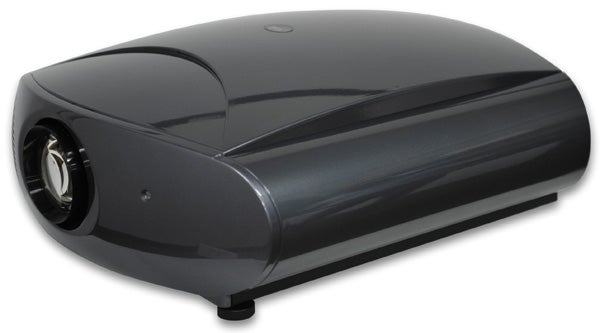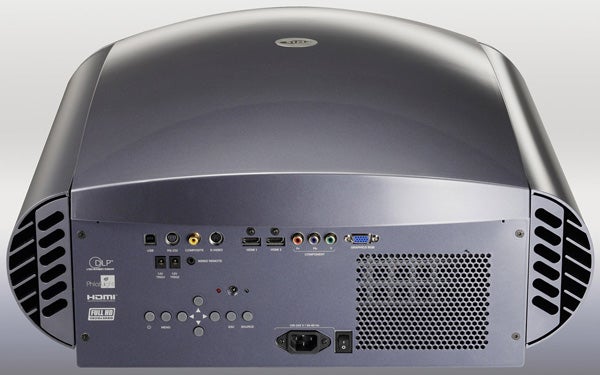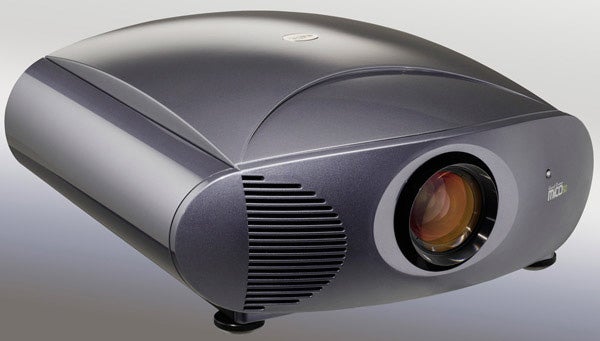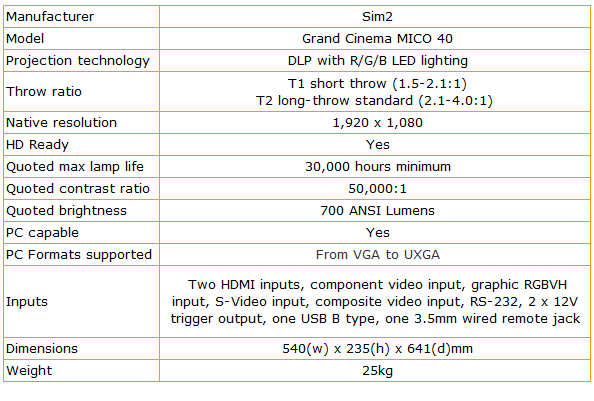SIM2 Grand Cinema MICO 40 Review
SIM2 Grand Cinema MICO 40
An LED DLP home cinema projector of exquisite quality.

Verdict
Key Specifications
- Review Price: £10995.00
During our review of Italian projector guru SIM2’s latest projector, a rather unexpected question kept cropping up. Namely, can any home cinema product that costs 11 grand ever be considered a bargain?
Doubtless many of our readers with normal lives, normal jobs and normal bank balances will immediately answer with a resounding ‘no’. But while we at TrustedReviews actually live entirely normal existences too – no mansions or Ferraris here, sad to say – we’re actually slightly different to most folk in that we’ve had the chance to spend some serious time with the MICO 40. And with every day that’s passed in its company, we’ve found ourselves feeling more and more inclined to see its £10,995 asking price as cheap for what the projector offers. So much so that we’ve honestly had moments where we’ve eyed the £380 or so a month it takes to buy a MICO 40 by instalments with genuine intent.
Ultimately, such trivial stuff as mortgages and paying for kids, cars, food and the like kept us from succumbing to temptation. But the very fact that the MICO 40 even seriously tempted us to go for it on our meagre salaries makes it a bargain – albeit a highly aspirational one! 
But we are, of course, getting ahead of ourselves. So let’s go right back to the beginning of our time with the MICO 40, and our feelings as we first got it out of its box.
It was pretty much a case of love at first sight. For despite costing only two-thirds as much as its MICO 50 brother, the MICO 40 is every inch as gorgeous, encasing its large, reassuringly heavy innards within a sumptuously glossy, beautifully curvaceous body that really could only have come from the sleek SIM2 stable. Seldom are ‘serious AV quality’ and ‘pretty design’ so comfortable bedfellows.
Internally, the MICO 40’s key defining characteristic is its use of a trio of LED lamps, one each for video’s red, green and blue colour components. The use of LEDs is significant for all sorts of reasons, kicking off with the fact that you should never have to change a bulb for at least 30,000 hours – or, more likely, within the projector’s realistic life cycle. Projectors with normal lamps, by comparison, will usually need replacement lamps within 2,000-4,000 hours.
As well as saving you money in the long term, not having to replace lamps also gives the MICO 40 some handy eco-friendly credentials. These are built on, moreover, by the fact that LED lamps can be instantly turned off without fear of damage, so you don’t have to waste power with post shut-down cooling fans like you do with normal projectors.
In more ‘green’ news, there’s no lead or mercury anywhere in the LED lamps, and thanks to LED’s impressive luminance to power ratio, SIM2 reckons the MICO 40 can give you a 200in picture from only the same running power as a typical 42in plasma TV.
The LED lamps drive a DarkChip 3 DLP chip, which as well as giving you DLP’s contrast and colour advantages also seems to avoid the rainbow noise problem normally associated with single-chip DLP projectors. Actually, SIM2’s so-called PureLED engine has been designed to pulse the LED’s exceptionally rapidly, producing a colour cycle of 20x for every frame of the picture in a bid to reduce colour artefacts and improve colour saturations, contrast and greyscale.
As if the MICO 40 wasn’t already looking mighty impressive for its money, it also comes equipped with SIM2‘s full roster of calibration tools. These include, most significantly, the facility to hook up to colour calibration software on a PC and fine-tune colours to within a millimetre of perfection.
Naturally any projector costing the MICO 40’s sort of money will be professionally installed for anyone who buys one, so you won’t have to worry about tackling the immensely sophisticated calibration tools yourself. But it’s reassuring to know they’re there.
As we fired the MICO 40 up, we could find only two areas for concern. One is the remote control, which is rather flimsy and bland for such a high-end projector, and doesn’t work particularly intuitively with the onscreen menus. The other potential problem is the projector’s rated brightness of just 700 ANSI Lumens – a far lower figure, in fact, than those seen with many projectors costing less than £2k, never mind north of £10k.
It takes hardly any time at all, though, for the MICO 40’s pictures to tuck this concern safely away. For actually, far from looking dull and flat, its pictures are actually startlingly dynamic and rich, immediately portraying – seemingly effortlessly – that combination of rich contrasts, stable colours and awesome colour finesse that we’ve come to see as the defining features of the luxury home cinema projector market.
The projector’s post-calibration colours are particularly telling, as they seem to contain parts of the colour spectrum lesser projectors just cannot reach. Even better, the projector’s colour processing is able to reproduce even the subtlest of colour blends without striping or patching.
The MICO 40’s reproduction of black colours is superb too, allowing even the darkest scenes to look totally natural and as full of depth as the bright scenes. This sort of bright and dark consistency is a rare find in the home cinema world, despite being crucial to recreating a truly cinematic experience.
The biggest surprise is how dynamic the MICO 40 looks with dark scenes. It was with these that we feared we’d really notice its on-paper lack of brightness, but in fact dark scenes look really quite punchy, and the projector copes extremely well when asked to portray a few bright highlights amid a mostly dark scene.
All of this just underlines a couple of points we’ve made before on TrustedReviews; first that you should never judge a projector or TV by the numbers on its spec sheet, and second that a strong contrast/black level performance is far more important to a convincing home theatre image than brightness.
The MICO 40’s slight lack of raw brightness does, of course, impose some limitations on you. You really need to watch it in a properly darkened room, for instance, and it hasn’t got the power to drive a screen larger than 200in across. But precious few people can accommodate screens larger than 150in, while anyone who spends £11k on a projector and then watches it in a non-darkened room wants their head examining.
Last but by no means least among the MICO 40’s pretty extraordinary set of picture talents, is its phenomenal sharpness. We’d expected there to have been a bit of ‘give’ in this area relative to the MICO 50 on account of the cheaper model’s reduced brightness. But actually the MICO 40 looks equally outstanding, at least during bright scenes, rendering HD sources with almost forensic precision.
This means the projector can be a little unforgiving of weak sources, but you won’t care about that one bit when you find your eyes eating up the spectacular detailing now found on a growing number of Blu-ray discs, HD console games and even (sometimes) Sky HD broadcasts.
If you’re wondering at this point just why you should even think about buying the five-grand-dearer MICO 50 instead of the MICO 40, it’s certainly a valid question. However, there are a few significant differences, most notably that the MICO 50 uses DarkChip 4 chipsets to produce a claimed 100,000:1 contrast ratio versus the 50,000:1 claimed for the MICO 40’s DarkChip 3 system. The MICO 50 also has a little more flexibility when it comes to setting the image’s brightness/contrast balance.
The net result of all this is that the MICO 50’s pictures look slightly punchier, and more significantly contain more subtle shadow detail in dark areas.
For us, though, the step down in quality with the MICO 40 isn’t as large as the £5k price difference would lead you to expect.
In fact, provided you can place it in the darkened room it deserves, the only real flaw we can find with the MICO 40 is that it runs with a slight buzzing noise. It’s not entirely clear what the source of this noise is; the fans are actually very quiet, not least because the projector carries a liquid cooling system. But the buzzing is certainly there, and may need to be worked around with some careful placement of the projector relative to your seating position. Still, this shouldn’t be a problem given that there are two different lens options available for the MICO 40: the short throw T1 (1.5-2.1:1) and long throw T2 (2.1-4.0:1).
Verdict
Although SIM2 hasn’t let us down with any of its projectors recently, we still had our doubts about the MICO 40. From reading the spec sheet, we just didn’t think it would have enough brightness to hit the heights required of its £11k price tag. In reality, though, it’s a projector of exquisite quality that really does represent excellent value for money despite costing 11 grand, and as such might just be our favourite SIM2 projector yet…


